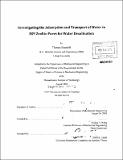| dc.contributor.advisor | Evelyn N. Wang. | en_US |
| dc.contributor.author | Humplik, Thomas | en_US |
| dc.contributor.other | Massachusetts Institute of Technology. Dept. of Mechanical Engineering. | en_US |
| dc.date.accessioned | 2011-04-25T16:14:54Z | |
| dc.date.available | 2011-04-25T16:14:54Z | |
| dc.date.copyright | 2010 | en_US |
| dc.date.issued | 2010 | en_US |
| dc.identifier.uri | http://hdl.handle.net/1721.1/62533 | |
| dc.description | Thesis (S.M.)--Massachusetts Institute of Technology, Dept. of Mechanical Engineering, 2010. | en_US |
| dc.description | Cataloged from PDF version of thesis. | en_US |
| dc.description | Includes bibliographical references (p. 71-74). | en_US |
| dc.description.abstract | The permeability of reverse osmosis membranes is limited by the diffusive transport of water across a non-porous polyamide active layer. Alternatively, fabricating a microporous active layer capable of rejecting salt ions while allowing for water transport would increase the permeability while maintaining high salt rejection. Zeolites provide a model porous network which is capable of performing this type of molecular sieve separation. However, a lack of understanding of the mechanisms that govern transport within the zeolite pore network as well as an insufficient control of membrane synthesis has limited the performance of past zeolite-based membranes. In this thesis, we seek to understand the mechanisms of water adsorption and transport in MFI-type zeolite pores through experimentation. Water adsorption on the surface and inside of the pore network was characterized by thermogravimetric analysis for varying Si/Al ratio zeolites. We estimated that the pore volume filled is -71% for a 23 Si/Al ratio MFI zeolite, -25% for an 80 Si/Al ratio MFI zeolite, and 0% for an infinite Si/Al ratio MFI zeolite. In addition, we characterized the transport of water into the MFI zeolite pore network by applying an increasing hydraulic pressure and measuring the change in volumetric displacement. We were able to corroborate the adsorbed pore volume from the TGA experiments and estimated that the pore volume filled was ~72% for a 23 Si/Al ratio MFI zeolite and ~34% for an 80 Si/Al ratio MFI zeolite. We also observed that the volumetric infiltration rate did not have an effect on the infiltration characteristics, which is distinctly different from continuum hydrodynamic behavior. Future work will focus on testing the water permeation and salt rejection of these types of zeolites. We have made significant progress in the fabrication of defect-free zeolite membranes. We also plan on investigating the adsorption and transport of water in MFI zeolite pores by using molecular dynamics simulations. | en_US |
| dc.description.statementofresponsibility | by Thomas Humplik. | en_US |
| dc.format.extent | 74 p. | en_US |
| dc.language.iso | eng | en_US |
| dc.publisher | Massachusetts Institute of Technology | en_US |
| dc.rights | M.I.T. theses are protected by
copyright. They may be viewed from this source for any purpose, but
reproduction or distribution in any format is prohibited without written
permission. See provided URL for inquiries about permission. | en_US |
| dc.rights.uri | http://dspace.mit.edu/handle/1721.1/7582 | en_US |
| dc.subject | Mechanical Engineering. | en_US |
| dc.title | Investigating the adsorption and transport of water in MFI zeolite pores for water desalination | en_US |
| dc.type | Thesis | en_US |
| dc.description.degree | S.M. | en_US |
| dc.contributor.department | Massachusetts Institute of Technology. Department of Mechanical Engineering | |
| dc.identifier.oclc | 712949359 | en_US |
